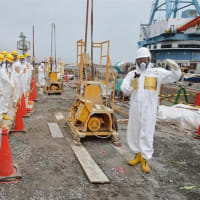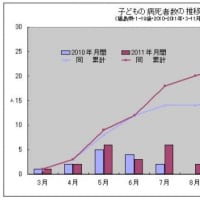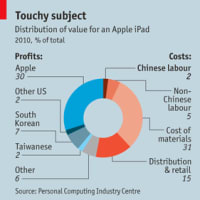
ここのところ、小麦みたいな農産品がかなり値上がりしているんですが、
クルーグマンコラムです。
Droughts, Floods and Food
We’re in the midst of a global food crisis ― the second in three years. World food prices hit a record in January, driven by huge increases in the prices of wheat, corn, sugar and oils. These soaring prices have had only a modest effect on U.S. inflation, which is still low by historical standards, but they’re having a brutal impact on the world’s poor, who spend much if not most of their income on basic foodstuffs.
世界規模の食料危機の真っただ中にある。3年間で2度目だ。小麦、コーン、砂糖、オイルの価格が冒頭している。米国経済には緩やかな影響しかもたらさずインフレも低い水準にとどまっている。しかし、食料支出に多くを費やす貧しい人達にはひどい影響をもたらしている。
The consequences of this food crisis go far beyond economics. After all, the big question about uprisings against corrupt and oppressive regimes in the Middle East isn’t so much why they’re happening as why they’re happening now. And there’s little question that sky-high food prices have been an important trigger for popular rage.
影響は経済にとどまらない。中東の腐敗して抑圧的な政権に対する反乱は、なぜ発生しているのか、というよりも、なぜ、今、発生しているのかってのが問題で、この高騰した食料価格が重要な引き金であることは疑いない。
So what’s behind the price spike? American right-wingers (and the Chinese) blame easy-money policies at the Federal Reserve, with at least one commentator declaring that there is “blood on Bernanke’s hands.” Meanwhile, President Nicolas Sarkozy of France blames speculators, accusing them of “extortion and pillaging.”
この高騰の背景はなにか。
FRBの金融緩和か、
投機が原因か。
But the evidence tells a different, much more ominous story. While several factors have contributed to soaring food prices, what really stands out is the extent to which severe weather events have disrupted agricultural production. And these severe weather events are exactly the kind of thing we’d expect to see as rising concentrations of greenhouse gases change our climate ― which means that the current food price surge may be just the beginning.
証拠がしめすところでは、それは違ってて、もっとずっとよろしくない。要因はいくつかあるが、特に目立つのは、厳しい気候変動がかなりの農業生産を崩壊させたことだ。
Now, to some extent soaring food prices are part of a general commodity boom: the prices of many raw materials, running the gamut from aluminum to zinc, have been rising rapidly since early 2009, mainly thanks to rapid industrial growth in emerging markets.
But the link between industrial growth and demand is a lot clearer for, say, copper than it is for food. Except in very poor countries, rising incomes don’t have much effect on how much people eat.
食料価格の上昇は商品ブームの一環でもあり、商品ブームは主に新興国の成長にともなって発生しているものだが、食料価格についてはそれほど関連が明確ではない。かなりの貧困国でないかぎり、所得の上昇は食べる量にそれほど影響しないのだ。
Still, food prices lagged behind the prices of other commodities until last summer. Then the weather struck.
去年の夏まで、食料価格は他の商品価格とは(完全に一致せず)ずれがあった。
その後、気候変動が襲ったのだ。
Consider the case of wheat, whose price has almost doubled since the summer. The immediate cause of the wheat price spike is obvious: world production is down sharply. The bulk of that production decline, according to U.S. Department of Agriculture data, reflects a sharp plunge in the former Soviet Union.
小麦で考えてみよう。小麦価格は去年の夏からほぼ2倍。原因は明らかだ。生産がひどく落ちたせいだ。農務省のデータによると生産が大規模に落ちたのは旧ソ連の生産下落を反映している。
And we know what that’s about: a record heat wave and drought, which pushed Moscow temperatures above 100 degrees for the first time ever.
そして,それは,記録的な熱波と旱魃のせいであって,モスクワでは初めて100度超えを記録したのだ。
The Russian heat wave was only one of many recent extreme weather events, from dry weather in Brazil to biblical-proportion flooding in Australia, that have damaged world food production.
異常気象はロシアだけにとどまらない。ブラジルの旱魃,オーストラリアの洪水も世界の食料生産をいためている。
The question then becomes, what’s behind all this extreme weather?
問題は,この背景に何があるかだ。
To some extent we’re seeing the results of a natural phenomenon, La Niña ― a periodic event in which water in the equatorial Pacific becomes cooler than normal. And La Niña events have historically been associated with global food crises, including the crisis of 2007-8.
ラニーニャもある程度はそうかも。
But that’s not the whole story. Don’t let the snow fool you: globally, 2010 was tied with 2005 for warmest year on record, even though we were at a solar minimum and La Niña was a cooling factor in the second half of the year. Temperature records were set not just in Russia but in no fewer than 19 countries, covering a fifth of the world’s land area. And both droughts and floods are natural consequences of a warming world: droughts because it’s hotter, floods because warm oceans release more water vapor.
でもそれだけじゃない。2010年は2005年と同じく,太陽の日照りは最小で,ラニーニャは年度後半に冷却要素として働いていたにもかかわらずもっとも暑かった年として記録された。ロシアだけが記録的に暑かったのではなく,19カ国以上,世界の5分の1がそうだったのだ。旱魃と洪水は暑さに続く自然の流れだ。暑くなれば旱魃が起きて,海水が熱せられればより多く水分が空気中に蒸発する。
As always, you can’t attribute any one weather event to greenhouse gases. But the pattern we’re seeing, with extreme highs and extreme weather in general becoming much more common, is just what you’d expect from climate change.
一つ一つの気象事件を温室効果ガスに原因を求めることはできない。しかし,今われわれが目撃しているひとつのパターンは,概して気温の異常な上昇や異常気象が共通にみられるという,気候変動によって予期されていたものに相違ない。
The usual suspects will, of course, go wild over suggestions that global warming has something to do with the food crisis; those who insist that Ben Bernanke has blood on his hands tend to be more or less the same people who insist that the scientific consensus on climate reflects a vast leftist conspiracy.
バーナンキの手は血で汚れているとか,気象に関する科学的合意は左派の陰謀だとする人たちは多かれ少なかれ同じような人たちで,世界温暖化が食料危機に関係すると聞けば激怒するんだろう。
But the evidence does, in fact, suggest that what we’re getting now is a first taste of the disruption, economic and political, that we’ll face in a warming world. And given our failure to act on greenhouse gases, there will be much more, and much worse, to come.
しかし証拠は、今のわれわれが被っている問題は、温暖化した世界が今後直面するであろう経済や政治の混乱の先駆けであることを示している。温暖化ガスへの対応に失敗すれば,もっともっとひどいことになるってこと。
とまあ,そういうわけですが,食料価格の高騰はしばらく落ち着いていたと思っていたら,またひどくあがってしまって,モスクワの旱魃や火事については去年大きなニュースにもなってましたね。
温暖化→異常気象→食料危機という流れは,まだ一般的な考え方ではないかも知れませんが,こうしたことが続くようだとちょいとヤバイことになるかもですな。
中東の民主化運動の背景に失業や,食料問題やら経済が絡んでいることは,多分議論のないところで,日本に居るとほとんど影響を感じないんですが,世界は確かに不安定になってる感じはあるんですね。
エジプトネタでは,ソーシャルメディアの影響が大きく取り上げられてましたが,これは,ちょいと気になるコラムなんですな。
クルーグマンコラムです。
Droughts, Floods and Food
We’re in the midst of a global food crisis ― the second in three years. World food prices hit a record in January, driven by huge increases in the prices of wheat, corn, sugar and oils. These soaring prices have had only a modest effect on U.S. inflation, which is still low by historical standards, but they’re having a brutal impact on the world’s poor, who spend much if not most of their income on basic foodstuffs.
世界規模の食料危機の真っただ中にある。3年間で2度目だ。小麦、コーン、砂糖、オイルの価格が冒頭している。米国経済には緩やかな影響しかもたらさずインフレも低い水準にとどまっている。しかし、食料支出に多くを費やす貧しい人達にはひどい影響をもたらしている。
The consequences of this food crisis go far beyond economics. After all, the big question about uprisings against corrupt and oppressive regimes in the Middle East isn’t so much why they’re happening as why they’re happening now. And there’s little question that sky-high food prices have been an important trigger for popular rage.
影響は経済にとどまらない。中東の腐敗して抑圧的な政権に対する反乱は、なぜ発生しているのか、というよりも、なぜ、今、発生しているのかってのが問題で、この高騰した食料価格が重要な引き金であることは疑いない。
So what’s behind the price spike? American right-wingers (and the Chinese) blame easy-money policies at the Federal Reserve, with at least one commentator declaring that there is “blood on Bernanke’s hands.” Meanwhile, President Nicolas Sarkozy of France blames speculators, accusing them of “extortion and pillaging.”
この高騰の背景はなにか。
FRBの金融緩和か、
投機が原因か。
But the evidence tells a different, much more ominous story. While several factors have contributed to soaring food prices, what really stands out is the extent to which severe weather events have disrupted agricultural production. And these severe weather events are exactly the kind of thing we’d expect to see as rising concentrations of greenhouse gases change our climate ― which means that the current food price surge may be just the beginning.
証拠がしめすところでは、それは違ってて、もっとずっとよろしくない。要因はいくつかあるが、特に目立つのは、厳しい気候変動がかなりの農業生産を崩壊させたことだ。
Now, to some extent soaring food prices are part of a general commodity boom: the prices of many raw materials, running the gamut from aluminum to zinc, have been rising rapidly since early 2009, mainly thanks to rapid industrial growth in emerging markets.
But the link between industrial growth and demand is a lot clearer for, say, copper than it is for food. Except in very poor countries, rising incomes don’t have much effect on how much people eat.
食料価格の上昇は商品ブームの一環でもあり、商品ブームは主に新興国の成長にともなって発生しているものだが、食料価格についてはそれほど関連が明確ではない。かなりの貧困国でないかぎり、所得の上昇は食べる量にそれほど影響しないのだ。
Still, food prices lagged behind the prices of other commodities until last summer. Then the weather struck.
去年の夏まで、食料価格は他の商品価格とは(完全に一致せず)ずれがあった。
その後、気候変動が襲ったのだ。
Consider the case of wheat, whose price has almost doubled since the summer. The immediate cause of the wheat price spike is obvious: world production is down sharply. The bulk of that production decline, according to U.S. Department of Agriculture data, reflects a sharp plunge in the former Soviet Union.
小麦で考えてみよう。小麦価格は去年の夏からほぼ2倍。原因は明らかだ。生産がひどく落ちたせいだ。農務省のデータによると生産が大規模に落ちたのは旧ソ連の生産下落を反映している。
And we know what that’s about: a record heat wave and drought, which pushed Moscow temperatures above 100 degrees for the first time ever.
そして,それは,記録的な熱波と旱魃のせいであって,モスクワでは初めて100度超えを記録したのだ。
The Russian heat wave was only one of many recent extreme weather events, from dry weather in Brazil to biblical-proportion flooding in Australia, that have damaged world food production.
異常気象はロシアだけにとどまらない。ブラジルの旱魃,オーストラリアの洪水も世界の食料生産をいためている。
The question then becomes, what’s behind all this extreme weather?
問題は,この背景に何があるかだ。
To some extent we’re seeing the results of a natural phenomenon, La Niña ― a periodic event in which water in the equatorial Pacific becomes cooler than normal. And La Niña events have historically been associated with global food crises, including the crisis of 2007-8.
ラニーニャもある程度はそうかも。
But that’s not the whole story. Don’t let the snow fool you: globally, 2010 was tied with 2005 for warmest year on record, even though we were at a solar minimum and La Niña was a cooling factor in the second half of the year. Temperature records were set not just in Russia but in no fewer than 19 countries, covering a fifth of the world’s land area. And both droughts and floods are natural consequences of a warming world: droughts because it’s hotter, floods because warm oceans release more water vapor.
でもそれだけじゃない。2010年は2005年と同じく,太陽の日照りは最小で,ラニーニャは年度後半に冷却要素として働いていたにもかかわらずもっとも暑かった年として記録された。ロシアだけが記録的に暑かったのではなく,19カ国以上,世界の5分の1がそうだったのだ。旱魃と洪水は暑さに続く自然の流れだ。暑くなれば旱魃が起きて,海水が熱せられればより多く水分が空気中に蒸発する。
As always, you can’t attribute any one weather event to greenhouse gases. But the pattern we’re seeing, with extreme highs and extreme weather in general becoming much more common, is just what you’d expect from climate change.
一つ一つの気象事件を温室効果ガスに原因を求めることはできない。しかし,今われわれが目撃しているひとつのパターンは,概して気温の異常な上昇や異常気象が共通にみられるという,気候変動によって予期されていたものに相違ない。
The usual suspects will, of course, go wild over suggestions that global warming has something to do with the food crisis; those who insist that Ben Bernanke has blood on his hands tend to be more or less the same people who insist that the scientific consensus on climate reflects a vast leftist conspiracy.
バーナンキの手は血で汚れているとか,気象に関する科学的合意は左派の陰謀だとする人たちは多かれ少なかれ同じような人たちで,世界温暖化が食料危機に関係すると聞けば激怒するんだろう。
But the evidence does, in fact, suggest that what we’re getting now is a first taste of the disruption, economic and political, that we’ll face in a warming world. And given our failure to act on greenhouse gases, there will be much more, and much worse, to come.
しかし証拠は、今のわれわれが被っている問題は、温暖化した世界が今後直面するであろう経済や政治の混乱の先駆けであることを示している。温暖化ガスへの対応に失敗すれば,もっともっとひどいことになるってこと。
とまあ,そういうわけですが,食料価格の高騰はしばらく落ち着いていたと思っていたら,またひどくあがってしまって,モスクワの旱魃や火事については去年大きなニュースにもなってましたね。
温暖化→異常気象→食料危機という流れは,まだ一般的な考え方ではないかも知れませんが,こうしたことが続くようだとちょいとヤバイことになるかもですな。
中東の民主化運動の背景に失業や,食料問題やら経済が絡んでいることは,多分議論のないところで,日本に居るとほとんど影響を感じないんですが,世界は確かに不安定になってる感じはあるんですね。
エジプトネタでは,ソーシャルメディアの影響が大きく取り上げられてましたが,これは,ちょいと気になるコラムなんですな。




















※コメント投稿者のブログIDはブログ作成者のみに通知されます